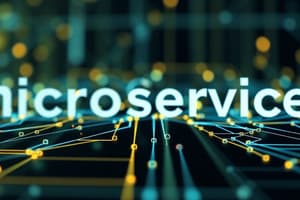Podcast
Questions and Answers
Quel est l'un des principaux avantages des microservices par rapport aux monolithes?
Quel est l'un des principaux avantages des microservices par rapport aux monolithes?
- Tous les composants sont centralisés
- Utilisation d'une seule technologie
- Complexité réduite des déploiements
- Évolutivité ciblée des services critiques (correct)
Quelle approche de gouvernance est utilisée dans une architecture de microservices?
Quelle approche de gouvernance est utilisée dans une architecture de microservices?
- Gouvernance par des instances tierces
- Gouvernance centralisée pour tous les services
- Gouvernance décentralisée pour chaque service (correct)
- Gouvernance uniforme pour la gestion des données
Quel est un inconvénient majeur des architectures microservices?
Quel est un inconvénient majeur des architectures microservices?
- Réduction de la vitesse de développement
- Aucune possibilité d'utilisation de plusieurs langages
- Échec de l'isolation des pannes
- Complexité accrue par rapport aux monolithes (correct)
Quel aspect est essentiel pour la gestion d'une architecture de microservices?
Quel aspect est essentiel pour la gestion d'une architecture de microservices?
Pourquoi la gestion des transactions distribuées peut-elle poser des défis dans les microservices?
Pourquoi la gestion des transactions distribuées peut-elle poser des défis dans les microservices?
Quel est le rôle principal de l'Architecte Fonctionnel chez Capgemini ?
Quel est le rôle principal de l'Architecte Fonctionnel chez Capgemini ?
Combien d'années d'expérience a l'individu dans le secteur des start-ups ?
Combien d'années d'expérience a l'individu dans le secteur des start-ups ?
Quel langage n'est pas mentionné dans le parcours professionnel ?
Quel langage n'est pas mentionné dans le parcours professionnel ?
Dans quelle spécialité a obtenu son Master l'individu ?
Dans quelle spécialité a obtenu son Master l'individu ?
Quel rôle l'individu n'occupe-t-il pas chez Capgemini ?
Quel rôle l'individu n'occupe-t-il pas chez Capgemini ?
Quel est l'un des langages utilisés par l'ingénieur R&D dans l'industrie Spatial-Défense ?
Quel est l'un des langages utilisés par l'ingénieur R&D dans l'industrie Spatial-Défense ?
Combien d'années d'expérience a l'individu dans le secteur des services financiers ?
Combien d'années d'expérience a l'individu dans le secteur des services financiers ?
Quel poste l'individu a-t-il occupé pendant 6 ans chez Capgemini Apps ?
Quel poste l'individu a-t-il occupé pendant 6 ans chez Capgemini Apps ?
Quels sont les avantages d'une application monolithique ?
Quels sont les avantages d'une application monolithique ?
Quelle caractéristique n'est pas associée aux microservices ?
Quelle caractéristique n'est pas associée aux microservices ?
Quelle limitation des applications monolithiques concerne la mise à jour du logiciel ?
Quelle limitation des applications monolithiques concerne la mise à jour du logiciel ?
Quel est le principal inconvénient de la taille d'une application monolithique ?
Quel est le principal inconvénient de la taille d'une application monolithique ?
Comment les microservices gèrent-ils les données ?
Comment les microservices gèrent-ils les données ?
Quel est un inconvénient majeur de l'évolutivité d'une application monolithique ?
Quel est un inconvénient majeur de l'évolutivité d'une application monolithique ?
Quel est le principe fondamental de l'autonomie des microservices ?
Quel est le principe fondamental de l'autonomie des microservices ?
Quel aspect d'une application monolithique complique la restauration en cas d'échec ?
Quel aspect d'une application monolithique complique la restauration en cas d'échec ?
Quel type de message a été enregistré lorsque la demande de création de commande a été reçue ?
Quel type de message a été enregistré lorsque la demande de création de commande a été reçue ?
Quel service a signalé que l'inventaire était faible pour un produit spécifique ?
Quel service a signalé que l'inventaire était faible pour un produit spécifique ?
Quel est le dernier événement enregistré dans la séquence des logs ?
Quel est le dernier événement enregistré dans la séquence des logs ?
Quel ID de corrélation a été utilisé lors de la création réussie d'une commande ?
Quel ID de corrélation a été utilisé lors de la création réussie d'une commande ?
Quel type de log indique le début d'un processus d'analyse ?
Quel type de log indique le début d'un processus d'analyse ?
Quel service a essayé d'interroger la base de données pour les analyses ?
Quel service a essayé d'interroger la base de données pour les analyses ?
Combien de services ont été impliqués dans le traitement de la commande enregistrée ?
Combien de services ont été impliqués dans le traitement de la commande enregistrée ?
Quelle est la nature de l'événement consigné avec le niveau d'erreur dans les logs ?
Quelle est la nature de l'événement consigné avec le niveau d'erreur dans les logs ?
Quel est le but principal du SSO (Single Sign-On) ?
Quel est le but principal du SSO (Single Sign-On) ?
Quel protocole permet d'accorder un accès limité à des applications tierces sans exposer les identifiants de l'utilisateur ?
Quel protocole permet d'accorder un accès limité à des applications tierces sans exposer les identifiants de l'utilisateur ?
Quelle est la combinaison offerte par OIDC ?
Quelle est la combinaison offerte par OIDC ?
Quelle affirmation résume le mieux la différence entre SSO et OAuth ?
Quelle affirmation résume le mieux la différence entre SSO et OAuth ?
Quel est l'objectif principal d'OIDC (OpenID Connect) ?
Quel est l'objectif principal d'OIDC (OpenID Connect) ?
Comment peut-on décrire le processus d'authentification associé à OIDC ?
Comment peut-on décrire le processus d'authentification associé à OIDC ?
Quelle option représente le mieux la relation entre OAuth et ressources utilisateur ?
Quelle option représente le mieux la relation entre OAuth et ressources utilisateur ?
Quel est l'élément clé qui différencie SSO des autres méthodes d'authentification ?
Quel est l'élément clé qui différencie SSO des autres méthodes d'authentification ?
Quel outil est principalement utilisé pour la visualisation des données et le suivi des performances ?
Quel outil est principalement utilisé pour la visualisation des données et le suivi des performances ?
Quel logiciel est spécialisé dans la collecte et l'indexation des données générées par les applications ?
Quel logiciel est spécialisé dans la collecte et l'indexation des données générées par les applications ?
Quel est le principal avantage de Grafana par rapport aux autres outils ?
Quel est le principal avantage de Grafana par rapport aux autres outils ?
Quel outil serait le plus approprié pour la gestion en temps réel des événements et des logs ?
Quel outil serait le plus approprié pour la gestion en temps réel des événements et des logs ?
Quel est le but principal de l'observabilité dans un système ?
Quel est le but principal de l'observabilité dans un système ?
Quel outil est souvent utilisé pour le suivi des métriques dans un système basé sur des microservices ?
Quel outil est souvent utilisé pour le suivi des métriques dans un système basé sur des microservices ?
Quel outil est souvent intégré à Grafana pour améliorer l’observabilité ?
Quel outil est souvent intégré à Grafana pour améliorer l’observabilité ?
Dans quel contexte Splunk est-il le plus efficace ?
Dans quel contexte Splunk est-il le plus efficace ?
Flashcards
Architecte Solution
Architecte Solution
Un professionnel qui conçoit et développe des solutions de manière globale en tenant compte des besoins métier et techniques.
Architecte Fonctionnel
Architecte Fonctionnel
Un expert qui analyse et définit les besoins fonctionnels d'une solution informatique.
Team Lead
Team Lead
Un leader d'équipe qui encadre et dirige une équipe de développeurs ou d'analystes.
Chef de projet Technique
Chef de projet Technique
Signup and view all the flashcards
Consultant
Consultant
Signup and view all the flashcards
Delegate
Delegate
Signup and view all the flashcards
Master MIA GE, spécialité Réseaux Distribués
Master MIA GE, spécialité Réseaux Distribués
Signup and view all the flashcards
Java
Java
Signup and view all the flashcards
Évolutivité (Microservices)
Évolutivité (Microservices)
Signup and view all the flashcards
Vitesse de développement (Microservices)
Vitesse de développement (Microservices)
Signup and view all the flashcards
Optimisation/Compatibilité (Microservices)
Optimisation/Compatibilité (Microservices)
Signup and view all the flashcards
Isolation des pannes (Microservices)
Isolation des pannes (Microservices)
Signup and view all the flashcards
Catalogue de services (Microservices)
Catalogue de services (Microservices)
Signup and view all the flashcards
Application monolithique
Application monolithique
Signup and view all the flashcards
Avantages des monolithes : Déploiement facile
Avantages des monolithes : Déploiement facile
Signup and view all the flashcards
Avantages des monolithes : Gestion de la complexité
Avantages des monolithes : Gestion de la complexité
Signup and view all the flashcards
Avantages des monolithes : Faible dépendance
Avantages des monolithes : Faible dépendance
Signup and view all the flashcards
Limitations des monolithes : Évolutivité coûteuse
Limitations des monolithes : Évolutivité coûteuse
Signup and view all the flashcards
Limitations des monolithes : Mise à jour fréquente
Limitations des monolithes : Mise à jour fréquente
Signup and view all the flashcards
Limitations des monolithes : Difficultés de correction
Limitations des monolithes : Difficultés de correction
Signup and view all the flashcards
Limitations des monolithes : Taille
Limitations des monolithes : Taille
Signup and view all the flashcards
SSO (Single Sign-On)
SSO (Single Sign-On)
Signup and view all the flashcards
OAuth 2.0
OAuth 2.0
Signup and view all the flashcards
OIDC (OpenID Connect)
OIDC (OpenID Connect)
Signup and view all the flashcards
Microservices
Microservices
Signup and view all the flashcards
CI/CD (Intégration continue et livraison continue)
CI/CD (Intégration continue et livraison continue)
Signup and view all the flashcards
DevOps
DevOps
Signup and view all the flashcards
Sécurisation des microservices
Sécurisation des microservices
Signup and view all the flashcards
Surveillance des microservices
Surveillance des microservices
Signup and view all the flashcards
Logs : Importance pour le débogage
Logs : Importance pour le débogage
Signup and view all the flashcards
Niveaux de gravité des logs
Niveaux de gravité des logs
Signup and view all the flashcards
Identifiant de corrélation (correlationId)
Identifiant de corrélation (correlationId)
Signup and view all the flashcards
Trace de pile (Stacktrace)
Trace de pile (Stacktrace)
Signup and view all the flashcards
Logs de débogage (DEBUG)
Logs de débogage (DEBUG)
Signup and view all the flashcards
Logs d'audit
Logs d'audit
Signup and view all the flashcards
Logs de performance
Logs de performance
Signup and view all the flashcards
Gestion de la conservation des logs
Gestion de la conservation des logs
Signup and view all the flashcards
Splunk
Splunk
Signup and view all the flashcards
Prometheus
Prometheus
Signup and view all the flashcards
Grafana
Grafana
Signup and view all the flashcards
Surveillance des logs
Surveillance des logs
Signup and view all the flashcards
Surveillance du système
Surveillance du système
Signup and view all the flashcards
Observabilité
Observabilité
Signup and view all the flashcards
Alertes
Alertes
Signup and view all the flashcards
Suivi des performances
Suivi des performances
Signup and view all the flashcards
Study Notes
Microservices & Cloud Computing - ESIEA 4a
- The course is held from 20/11/2024 to 21/11/2024
- The course is offered by ESIEA, in the 4a year.
- The speakers are Kevin Navarri, Thomas Desrut, and Julien Trouillet.
Agenda
- The agenda includes 4 presentations about Cloud Concepts
- The first presentation introduces the concept of IT systems (SI)
- The second presentation covers Microservices and Cloud Computing
- The third presentation focuses on Cloud Architecture
- The fourth presentation discusses Cloud Scalability
Agenda (Microservices)
- The agenda for the Microservices presentation covers:
- About Us
- Introduction to Microservices
- Essential Microservices Patterns
- Securing Microservices
- Deploying and Maintaining Microservices
- Logging
- Monitoring
- Introduction to Cloud Computing
Monolite Applications
- Monoliths are single-tiered software applications where different modules are combined into one program.
- Benefits include easy deployment and managed complexity.
- Limitations include costly scalability, infrequent updates, and the potential for significant rollout issues.
Microservices
- In contrast to monoliths, microservices are mini-applications with unique features and functionality.
- Key properties include modularity, autonomy, and data decentralization.
Microservices - Benefits
- Scalability: Resource usage is optimized by scaling only the needed components.
- Development speed: Individual teams can deploy independent services more quickly
- Optimization/Compatibility : Developers can utilize various languages to maximize efficiency.
- Fault Isolation: Failure within one service won't affect the entire system.
Decentralized Architecture
- The shift from a centralized governance model in monoliths to a decentralized model in microservices is highlighted.
- Microservices (per service governance) permits each team to follow its own timeline (schedule and roadmap)
- Service Catalog is used as a repository listing details of various services (making discovery, reuse, and monitoring easy).
- While microservices architectures are more complex, proper cataloging and distributed transactions support the decentralized model.
Notable Example: Netflix with AWS
- Netflix used an AWS-based microservices architecture to avoid the issues often associated with monoliths (e.g., difficulties with memory leaks, network latency, congestion, failure, or scaling issues)
- This notable example illustrates the distinct architecture from the monolithic approach.
Authentication vs Authorization
- Authentication verifies the user's identity through credentials (passwords, tokens, biometric data).
- Authorization defines the granted permissions for authenticated users or actions they can perform.
SSO and JWT Patterns
- Single Sign-On (SSO) permits users to log in once to access multiple applications.
- OAuth 2.0 grants limited access to third-party applications, without exposing credentials.
- OpenID Connect (OIDC) is an identity layer built on top of OAuth 2.0, which is commonly used for verifying user identity and profile access and information in SSO contexts.
OAuth Pattern
- The OAuth protocol describes how users can grant limited access to third-party applications that need to access user information provided by a resource owner (like a social media account).
- Steps involved: User initiates the request, the resource owner gets confirmation, the access token is given to the third-party application.
OIDC Pattern
- OpenID Connect (OIDC) is an authentication protocol that provides standards to verify user identity using OAuth 2.0.
- The IdP (Identity Provider) verifies a client's identity and permissions.
- The token (and access details) are passed back to the initial application.
CI/CD and DevOps
- CI/CD stands for Continuous Integration and Continuous Delivery
- DevOps is used to create automation pipelines
CI/CD for a Java project
- Various tools (e.g., Jenkins, Maven, SonarQube, Docker) are used for code quality checks, compilation, dependency checking, deployment, and containerization, resulting in a seamless CI/CD pipeline.
Centralized Logging Tools (ELK Stack)
- ELK Stack (Elasticsearch, Logstash, Kibana): Aggregation of logs across various services
- Tools aggregate, process, and visualize logs across services.
Importance of Logs for Diagnostics
- Logs are valuable for quickly pinpointing troubleshooting difficulties, resolving issues, and assessing performance/efficiency.
Monitoring Tools
- Grafana : Open-source platform for data visualization and monitoring.
- Splunk: Data analytics platform used to collect, index, and visualize machine data.
- Prometheus: An open-source system for monitoring and alerting on applications, servers and other IT systems.
Importance of Observability
- Observability enhances the ability of development teams to promptly identify potential system or application failures with minimal effort.
Cloud Services
- On-demand IT services
- Automated deployment
- Elasticity
- Pay per use model
Non-Cloud vs Cloud Projects
- Non-cloud projects ('Pets'): personalized, unique projects.
- Cloud projects ('Cattle'): repetitive and standardized projects.
Liabilities (Clouders vs Client)
- Customer responsibility for security within the cloud.
- AWS responsibility for security outside the cloud, in their infrastructure.
Contact Information
- Contact information for the speakers is provided.
Studying That Suits You
Use AI to generate personalized quizzes and flashcards to suit your learning preferences.




